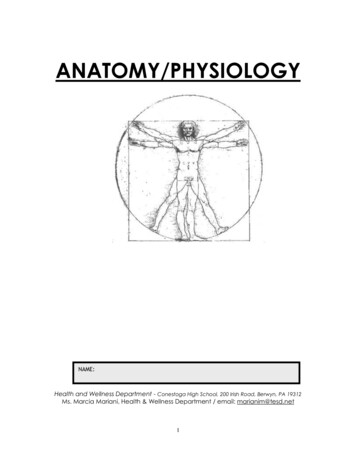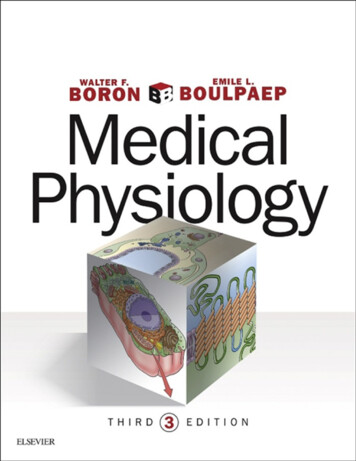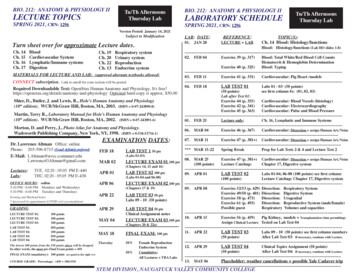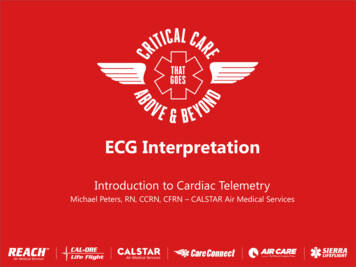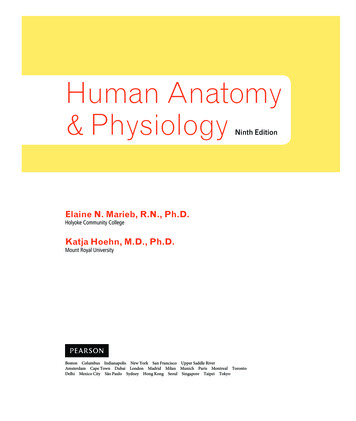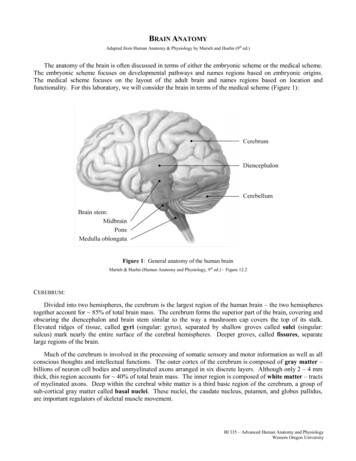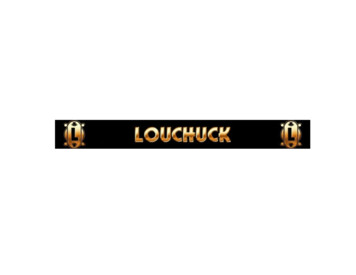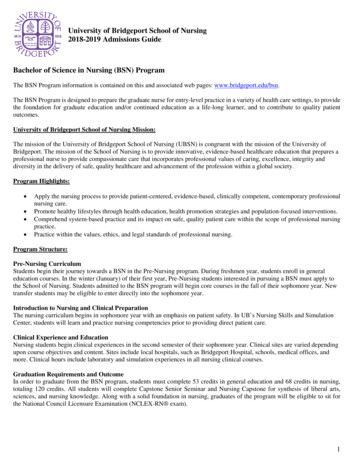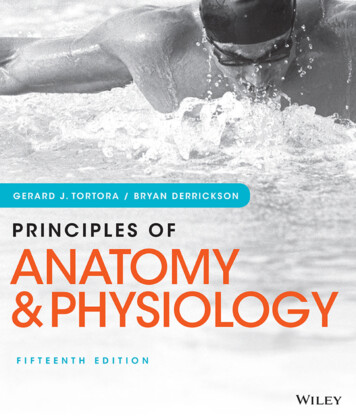
Transcription
Principles ofANATOMY & PHYSIOLOGY15th EditionGERARD J. TORTORABergen Community CollegeBRYAN DERRICKSONValencia College
VICE PRESIDENT AND DIRECTORSENIOR EDITORASSOCIATE DEVELOPMENT EDITORASSISTANT DEVELOPMENT EDITOREDITORIAL ASSISTANTSENIOR MARKETING MANAGERSENIOR CONTENT MANAGERSENIOR PRODUCTION EDITORSENIOR PHOTO EDITORSENIOR PRODUCT DESIGNERTEXT AND COVER DESIGNERCOVER PHOTOPetra RecterMaria GuarascioLaura RamaLindsey MyersMaryAlice SkidmoreAlan HalfenSvetlana BarskayaTrish McFaddenMaryAnn PriceLinda MurielloThomas Nery PhotoAlto sas/Alamy Stock PhotoThis book was set in 9.5/12.5 Source Sans Pro by Aptara , Inc. Printed and bound by Quad Graphics. This book is printed on acid-freepaper. Founded in 1807, John Wiley & Sons, Inc. has been a valued source of knowledge and understanding for more than 200 years, helpingpeople around the world meet their needs and fulfill their aspirations. Our company is built on a foundation of principles that includeresponsibility to the communities we serve and where we live and work. In 2008, we launched a Corporate Citizenship Initiative, aglobal effort to address the environmental, social, economic, and ethical challenges we face in our business. Among the issues we areaddressing are carbon impact, paper specifications and procurement, ethical conduct within our business and among our vendors,and community and charitable support. For more information, please visit our website: www.wiley.com/go/citizenship.Copyright 2017 John Wiley & Sons, Inc. All rights reserved.No part of this publication may be reproduced, stored in a retrieval system, or transmitted in any form or by any means, electronic,mechanical, photocopying, recording, scanning or otherwise, except as permitted under Sections 107 or 108 of the 1976 United StatesCopyright Act, without either the prior written permission of the Publisher, or authorization through payment of the appropriate percopy fee to the Copyright Clearance Center, Inc., 222 Rosewood Drive, Danvers, MA 01923 (website: www.copyright.com). Requests tothe Publisher for permission should be addressed to the Permissions Department, John Wiley & Sons, Inc., 111 River Street, Hoboken,NJ 07030-5774, (201) 748-6011, fax (201) 748-6008, or online at: www.wiley.com/go/permissions.Evaluation copies are provided to qualified academics and professionals for review purposes only, for use in their courses during thenext academic year. These copies are licensed and may not be sold or transferred to a third party. Upon completion of the reviewperiod, please return the evaluation copy to Wiley. Return instructions and a free-of-charge return shipping label are available at:www.wiley.com/go/returnlabel. If you have chosen to adopt this textbook for use in your course, please accept this book as your complimentary desk copy. Outside of the United States, please contact your local representative.ePUB ISBN 978-1-119-32064-7The inside back cover will contain printing identification and country of origin if omitted from this page. In addition, if the ISBN on theback cover differs from the ISBN on this page, the one on the back cover is correct.Printed in the United States of America.10987654321
About the AuthorsJERRY TORTOR A is Professor of Biology and former Biology Coordinator at Bergen Community College in Paramus, New Jersey, wherehe teaches human anatomy and physiology as well as microbiology.He received his bachelor’s degree in biology from Fairleigh DickinsonUniversity and his master’s degree in science education from Montclair State College. He has been a member of many professional organizations, including the Human Anatomy and Physiology Society(HAPS), the American Society of Microbiology (ASM), American Association for the Advancement of Science (AAAS), National EducationAssociation (NEA), and the Metropolitan Association of College andUniversity Biologists (MACUB).Above all, Jerry is devoted to his students and their aspirations. Inrecognition of this commitment, Jerry was the recipient of MACUB’s 1992President’s Memorial Award. In 1996, he received a National Institute forStaff and Organizational Development (NISOD) excellence award fromthe University of Texas and was selected to represent Bergen Community College in a campaign to increase awareness of the contributions ofcommunity colleges to higher education.Jerry is the author of several best-selling science textbooks andlaboratory manuals, a calling that often requires an additional 40 hoursper week beyond his teaching responsibilities. Nevertheless, he stillmakes time for four or five weekly aerobic workouts that includebiking and running. He also enjoys attending college basketball andprofessional hockey games and performances at the MetropolitanOpera House.BRYAN DERRICKSON is Professor of Biology at Valencia College inOrlando, Florida, where he teaches human anatomy and physiologyas well as general biology and human sexuality. He received his bachelor’s degree in biology from Morehouse College and his Ph.D. in cellbiology from Duke University. Bryan’s study at Duke was in the Physiology Division within the Department of Cell Biology, so while his degree is in cell biology, his training focused on physiology. At Valencia,he frequently serves on faculty hiring committees. He has served asa member of the Faculty Senate, which is the governing body of thecollege, and as a member of the Faculty Academy Committee (nowcalled the Teaching and Learning Academy), which sets the standards for the acquisition of tenure by faculty members. Nationally, heis a member of the Human Anatomy and Physiology Society (HAPS)and the National Association of Biology Teachers (NABT). Bryan hasalways wanted to teach. Inspired by several biology professors whilein college, he decided to pursue physiology with an eye to teachingat the college level. He is completely dedicated to the success of hisstudents. He particularly enjoys the challenges of his diverse studentpopulation, in terms of their age, ethnicity, and academic ability,and finds being able to reach all of them, despite their differences,a rewarding experience. His students continually recognize Bryan’sefforts and care by nominating him for a campus award known asthe “Valencia Professor Who Makes Valencia a Better Place to Start.”Bryan has received this award three times.To all my children: Lynne, Gerard Jr., Kenneth, Anthony,and Drew, whose love and support have been the windbeneath my wings. GJTTo my family: Rosalind, Hurley, Cherie, and Robb.Your support and motivation have been invaluable to me.B.H.D.
PrefaceWelcome to your course in anatomy and physiology! Many of you aretaking this course because you hope to pursue a career in one of theallied health fields or nursing. Or perhaps you are simply interested inlearning more about your own body. Whatever your motivation, Principles of Anatomy and Physiology, 15th edition and WileyPLUS haveall the content and tools that you need to successfully navigate whatcan be a very challenging course.Over the past fourteen editions of this text we have made everyeffort to provide you with an accurate, clearly written, and expertlyillustrated presentation of the structure and function of the humanbody and to explore the practical and relevant applications of yourknowledge to everyday life and career development. This fifteenthedition remains true to these goals. It distinguishes itself from prioreditions with updated and new illustrations and enhanced digitalonline learning resources.Engaging DigitallyThe content in Principles of Anatomy and Physiology is completelyintegrated into WileyPLUS. This allows you to create a personalizedstudy plan, assess your progress along the way, and access the content and resources you need to master the material. WileyPLUS provides immediate insight into your strengths and problem areas withvisual reports that highlight what’s most important for you to act on.Many dynamic programs integrated into the course help buildyour knowledge and understanding, and keep you motivated. Fifteen 3-D Physiology animations were developed around the mostdifficult physiological concepts to help students like you understand them more effectively. Muscles in Motion are animationsof the seven major joints of the body, helping you learn origin,insertion, and movements of muscles surrounding those joints.Real Anatomy is 3-D imaging software that allows you to dissectthrough multiple layers of a real human body to study and learn theanatomical structures of all body systems. And Anatomy Drill andPractice lets you test your knowledge of structures with easy dragand-drop or fill-in-the-blank labeling exercises. You can practice labeling illustrations, cadaver photographs, histology micrographs,or anatomical models.WileyPLUS also includes ORION – integrated adaptive practice that helps you build proficiency and use your study time mosteffectively.AcknowledgmentsPrinciples of Human Anatomy & Physiology 15e and WileyPLUS with ORIONwould not be possible without the help of many, particularly the academiccolleagues who collaborated with us along the way. We are very grateful thatWiley has commissioned a board of advisors in anatomy and physiology to actas a sounding board on course issues, challenges, and solutions. In particularwe thank those members of the board with expertise in the 2-semester A&Pcourse: DJ Hennager, Kirkwood Community College; Heather Labbe, University of Montana-Missoula; Tom Lancraft, St. Petersburg College; Russel Nolan,Baton Rouge Community College; and Terry Thompson, Wor-Wic CommunityCollege.We wish to especially thank several academic colleagues for their helpful contributions to this edition, particularly to WileyPLUS with ORION. Theimprovements and enhancements for this edition are possible in large partbecause of the expertise and input of the following group of people:Matthew Abbott, Des Moines Area Community CollegeAyanna Alexander-Street, Lehman College of New YorkDonna Balding, Macon State CollegeCelina Bellanceau, Florida Southern CollegeDena Berg, Tarrant County CollegeBetsy Brantley, Valencia Community CollegeSusan Burgoon, Armadillo CollegeivSteven Burnett, Clayton State UniversityHeidi Bustamante, University of Colorado, BoulderAnthony Contento, Colorado State UniversityLiz Csikar, Mesa Community CollegeKent Davis, Brigham Young University, IdahoKathryn Durham, Lorain County Community CollegeKaushik Dutta, University of New EnglandKaren Eastman, Chattanooga State Community CollegeJohn Erickson, Ivy Tech Community College of IndianaTara Fay, University of ScrantonJohn Fishback, Ozark Tech Community CollegeLinda Flora, Delaware County Community CollegeAaron Fried, Mohawk Valley Community CollegeSophia Garcia, Tarrant County Community CollegeLynn Gargan, Tarrant County Community CollegeCaroline Garrison, Carroll Community CollegeHarold Grau, Christopher Newport UniversityMark Hubley, Prince George’s Community CollegeJason Hunt, Brigham Young University, IdahoLena Garrison, Carroll Community CollegeGeoffrey Goellner, Minnesota State University, Mankato
AC K NOWLED GMENTSDJ Hennager, Kirkwood Community CollegeLisa Hight, Baptist College of Health SciencesAlexander Imholtz, Prince George’s Community CollegeMichelle Kettler, University of WisconsinCynthia Kincer, Wytheville Community CollegeTom Lancraft, St. Petersburg CollegeClaire Leonard, William Paterson UniversityJerri Lindsey, Tarrant County Community CollegeAlice McAfee, University of ToledoShannon Meadows, Roane State Community CollegeShawn Miller, University of UtahErin Morrey, Georgia Perimeter CollegeQian Moss, Des Moines Area Community CollegeMark Nielsen, University of UtahMargaret Ott, Tyler Junior CollegeEileen Preseton, Tarrant County CollegeSaeed Rahmanian, Roane State Community CollegeSandra Reznik, St. John’s UniversityLaura Ritt, Burlington Community CollegeAmanda Rosenzweig, Delgado Community CollegeJeffrey Spencer, University of AkronSandy Stewart, Vincennes UniversityJane Torrie, Tarrant County CollegevMaureen Tubbiola, St. Cloud StateJamie Weiss, William Paterson UniversityFinally, our hats are off to everyone at Wiley. We enjoy collaborating with thisenthusiastic, dedicated, and talented team of publishing professionals. Ourthanks to the entire team: Maria Guarascio, Senior Editor; Linda Muriello, Senior Product Designer; Lindsey Myers, Assistant Development Editor; MaryAliceSkidmore, Editorial Assistant; Trish McFadden, Content Management Editor;Mary Ann Price, Photo Manager; Tom Nery, Designer; and Alan Halfen, SeniorMarketing Manager.GERARD J. TORTORADepartment of Science and Health, S229Bergen Community College400 Paramus RoadParamus, NJ 07652gjtauthor01@optonline.comBRYAN DERRICKSONDepartment of Science, PO Box 3028Valencia CollegeOrlando, FL 32802bderrickson@valenciacollege.edu
A personalized, adaptivelearning experience.WileyPLUS with ORION delivers easy-to-use analytics that helpeducators and students see strengths and weaknesses to give learnersthe best chance of succeeding in the course.Photo credit: Monkey Business Images/ShutterstockIdentify which studentsare struggling early in thesemester.Help students organizetheir learning and get thepractice they need.Measure outcomesto promote continuousimprovement.Educators assess the real-timeengagement and performance ofeach student to inform teachingdecisions. Students always knowwhat they need to work on.With ORION’s adaptive practice,students quickly understandwhat they know and don’t know.They can then decide to study orSUDFWLFH EDVHG RQ WKHLU SURȴFLHQF\ With visual reports, it’s easy forboth students and educators togauge problem areas and act onwhat’s most important.www.ORION.wileyplus.com
Brief ContentsPREFACEiv1An Introduction to the Human Body 12The Chemical Level of Organization 283The Cellular Level of Organization 604The Tissue Level of Organization 1065The Integumentary System 1446The Skeletal System: Bone Tissue 1717The Skeletal System: The Axial Skeleton 1948The Skeletal System: The Appendicular Skeleton 2349Joints 26010Muscular Tissue 29311The Muscular System 33012Nervous Tissue 40313The Spinal Cord and Spinal Nerves 44614The Brain and Cranial Nerves 47715The Autonomic Nervous System 52616Sensory, Motor, and Integrative Systems 54817The Special Senses 57618The Endocrine System 62219The Cardiovascular System: The Blood 66820The Cardiovascular System: The Heart 69521The Cardiovascular System: Blood Vessels and Hemodynamics 73722The Lymphatic System and Immunity 80823The Respiratory System 85024The Digestive System 898vii
viiiB RIE F CONTENTS25Metabolism and Nutrition 95326The Urinary System 99327Fluid, Electrolyte, and Acid–Base Homeostasis 103628The Reproductive Systems 105529Development and Inheritance 1107APPE N D I X AMeasurements A-1APPE N D I X BPeriodic Table B-3APPE N D I X CNormal Values for Selected Blood Tests C-4GLOSSARY / INDEX
Contents1 An Introduction to the HumanBody11.11.21.3Anatomy and Physiology Defined 2Levels of Structural Organization and Body Systems 2Characteristics of the Living HumanOrganism 51.4 Homeostasis 81.5 Basic Anatomical Terminology 131.6 Aging and Homeostasis 211.7 Medical Imaging 22Chapter Review 25 / Critical Thinking Questions 27 / Answers toFigure Questions 272 The Chemical Level ofOrganizationHow Matter Is Organized 29Chemical Bonds 32Chemical Reactions 36Inorganic Compounds andSolutions 392.5 Overview of Organic Compounds 432.6 Carbohydrates 442.7 Lipids 462.8 Proteins 492.9 Nucleic Acids 542.10 Adenosine Triphosphate 56Chapter Review 57 / Critical Thinking Questions 59 /Answers to Figure Questions 593 The Cellular Level of3.13.23.31064.14.24.3Types of Tissues 107Cell Junctions 108Comparison between Epithelial and ConnectiveTissues 1094.4 Epithelial Tissue 1104.5 Connective Tissue 1224.6 Membranes 1334.7 Muscular Tissue 1354.8 Nervous Tissue 1374.9 Excitable Cells 1384.10 Tissue Repair: Restoring Homeostasis 1384.11 Aging and Tissues 139Chapter Review 141 / Critical Thinking Questions 142 /Answers to Figure Questions 143282.12.22.32.4Organization4 The Tissue Level of Organization5 The Integumentary System5.15.25.35.45.55.6Structure of the Skin 145Accessory Structures of the Skin 152Types of Skin 158Functions of the Skin 158Maintaining Homeostasis: Skin Wound Healing 160Development of the IntegumentarySystem 1615.7 Aging and the IntegumentarySystem 163Chapter Review 169 / Critical Thinking Questions 170 /Answers to Figure Questions 1706 The Skeletal System: BoneTissue60Parts of a Cell 61The Plasma Membrane 62Transport across the PlasmaMembrane 653.4 Cytoplasm 743.5 Nucleus 853.6 Protein Synthesis 883.7 Cell Division 923.8 Cellular Diversity 993.9 Aging and Cells 99Chapter Review 102 / Critical Thinking Questions 104 /Answers to Figure Questions 1051441716.1Functions of Bone and the SkeletalSystem 1726.2 Structure of Bone 1726.3 Histology of Bone Tissue 1746.4 Blood and Nerve Supply of Bone 1776.5 Bone Formation 1786.6 Fracture and Repair of Bone 1856.7 Bone’s Role in Calcium Homeostasis 1886.8 Exercise and Bone Tissue 1896.9 Aging and Bone Tissue 189Chapter Review 192 / Critical Thinking Questions 193 /Answers to Figure Questions 193ix
xCONTE NTS7 The Skeletal System: The AxialSkeleton1947.1Divisions of the SkeletalSystem 1957.2 Types of Bones 1977.3 Bone Surface Markings 1977.4 Skull: An Overview 1987.5 Cranial Bones 1997.6 Facial Bones 2087.7 Special Features of the Skull 2107.8 Hyoid Bone 2157.9 Vertebral Column 2157.10 Vertebral Regions 2187.11 Thorax 225Chapter Review 231 / Critical Thinking Questions 232 /Answers to Figure Questions 2322348.18.28.38.48.5Pectoral (Shoulder) Girdle 235Upper Limb (Extremity) 238Pelvic (Hip) Girdle 243False and True Pelves 245Comparison of Female and MalePelves 2478.6 Lower Limb (Extremity) 2478.7 Development of the Skeletal System 255Chapter Review 2599 Joints9.19.29.39.49.529310.1 Overview of Muscular Tissue 29410.2 Structure of Skeletal Muscle Tissue 29510.3 Contraction and Relaxation of Skeletal MuscleFibers 30410.4 Muscle Metabolism 31210.5 Control of Muscle Tension 31510.6 Types of Skeletal Muscle Fibers 31810.7 Exercise and Skeletal Muscle Tissue 31910.8 Cardiac Muscle Tissue 32110.9 Smooth Muscle Tissue 32110.10 Regeneration of Muscular Tissue 32310.11 Development of Muscle 32510.12 Aging and Muscular Tissue 325Chapter Review 327 / Critical Thinking Questions 329 /Answers to Figure Questions 32911 The Muscular System8 The Skeletal System: TheAppendicular Skeleton10 Muscular Tissue260Joint Classifications 261Fibrous Joints 261Cartilaginous Joints 263Synovial Joints 264Types of Movements at SynovialJoints 2669.6 Types of Synovial Joints 2719.7 Factors Affecting Contact and Range of Motion atSynovial Joints 2749.8 Selected Joints of the Body 2749.9 Temporomandibular Joint 2779.10 Shoulder Joint 2789.11 Elbow Joint 2819.12 Hip Joint 2829.13 Knee Joint 2849.14 Aging and Joints 2879.15 Arthroplasty 287Chapter Review 291 / Critical Thinking Questions 292 /Answers to Figure Questions 29211.111.211.311.4330How Skeletal Muscles Produce Movements 331How Skeletal Muscles Are Named 335Overview of the Principal Skeletal Muscles 335Muscles of the Head That Produce FacialExpressions 33911.5 Muscles of the Head That Move the Eyeballs (ExtrinsicEye Muscles) and Upper Eyelids 34211.6 Muscles That Move the Mandible and Assist inMastication and Speech 34411.7 Muscles of the Head That Move the Tongue and Assist inMastication and Speech 34511.8 Muscles of the Anterior Neck That Assist in Deglutitionand Speech 34711.9 Muscles of the Neck That Move the Head 34911.10 Muscles of the Abdomen That Protect AbdominalViscera and Move the Vertebral Column 35111.11 Muscles of the Thorax That Assist inBreathing 35411.12 Muscles of the Pelvic Floor That Support the PelvicViscera and Function as Sphincters 35711.13 Muscles of the Perineum 35811.14 Muscles of the Thorax That Move the PectoralGirdle 36011.15 Muscles of the Thorax and Shoulder That Move theHumerus 36311.16 Muscles of the Arm That Move the Radius andUlna 36611.17 Muscles of the Forearm That Move the Wrist, Hand,Thumb, and Digits 37011.18 Muscles of the Palm That Move the Digits—IntrinsicMuscles of the Hand 37511.19 Muscles of the Neck and Back That Move theVertebral Column 379
CONTENTS11.20 Muscles of the Gluteal Region That Move theFemur 38311.21 Muscles of the Thigh That Move the Femur,Tibia, and Fibula 38911.22 Muscles of the Leg That Move the Foot andToes 39111.23 Intrinsic Muscles of the Foot That Move theToes 396Chapter Review 401 / Critical Thinking Questions 402 /Answers to Figure Questions 40212 Nervous Tissue14.9 Olfactory (I) Nerve 50714.10 Optic (II) Nerve 50814.11 Oculomotor (III), Trochlear (IV), and Abducens (VI)Nerves 50914.12 Trigeminal (V) Nerve 51114.13 Facial (VII) Nerve 51214.14 Vestibulocochlear (VIII) Nerve 51314.15 Glossopharyngeal (IX) Nerve 51414.16 Vagus (X) Nerve 51514.17 Accessory (XI) Nerve 51614.18 Hypoglossal (XII) Nerve 51714.19 Development of the Nervous System 51914.20 Aging and the Nervous System 521Chapter Review 523 / Critical Thinking Questions 525 /Answers to Figure Questions 52540312.1 Overview of the Nervous System 40412.2 Histology of Nervous Tissue 40612.3 Electrical Signals in Neurons: An Overview 41412.4 Resting Membrane Potential 41812.5 Graded Potentials 42012.6 Action Potentials 42212.7 Signal Transmission at Synapses 42812.8 Neurotransmitters 43512.9 Neural Circuits 43812.10 Regeneration and Repair of NervousTissue 440Chapter Review 442 / Critical Thinking Questions 444 /Answers to Figure Questions 44415 The Autonomic NervousSystem15.1 Comparison of Somatic and Autonomic NervousSystems 52715.2 Anatomy of Autonomic MotorPathways 52915.3 ANS Neurotransmitters and Receptors 53715.4 Physiology of the ANS 54015.5 Integration and Control of AutonomicFunctions 543Chapter Review 546 / Critical Thinking Questions 546 /Answers to Figure Questions 54713 The Spinal Cord and SpinalNerves44616 Sensory, Motor, and Integrative13.1 Spinal Cord Anatomy 44713.2 Spinal Nerves 45313.3 Cervical Plexus 45613.4 Brachial Plexus 45813.5 Lumbar Plexus 46113.6 Sacral and Coccygeal Plexuses 46313.7 Spinal Cord Physiology 465Chapter Review 475 / Critical Thinking Questions 476 /Answers to Figure Questions 47614 The Brain and Cranial NervesSystems54816.1 Sensation 54916.2 Somatic Sensations 55216.3 Somatic Sensory Pathways 55716.4 Control of Body Movement 56216.5 Integrative Functions of the Cerebrum 569Chapter Review 574 / Critical Thinking Questions 575 /Answers to Figure Questions 57547714.1 Brain Organization, Protection, andBlood Supply 47814.2 Cerebrospinal Fluid 48114.3 The Brainstem and ReticularFormation 48614.4 The Cerebellum 49114.5 The Diencephalon 49314.6 The Cerebrum 49614.7 Functional Organization of the Cerebral Cortex14.8 Cranial Nerves: An Overview 50652617 The Special : Sense of Smell 577Gustation: Sense of Taste 580Vision: An Overview 584Accessory Structures of theEye 584Anatomy of the Eyeball 587Physiology of Vision 592Hearing 601Equilibrium 610576xi
xiiCONTE NTS17.9 Development of the Eyes and Ears 61517.10 Aging and the Special Senses 617Chapter Review 619 / Critical Thinking Questions 620 /Answers to Figure Questions 62018 The Endocrine System62218.1 Comparison of Control by the Nervous and EndocrineSystems 62318.2 Endocrine Glands 62318.3 Hormone Activity 62418.4 Mechanisms of Hormone Action 62618.5 Control of Hormone Secretion 62918.6 Hypothalamus and Pituitary Gland 63018.7 Thyroid Gland 63918.8 Parathyroid Glands 64318.9 Adrenal Glands 64618.10 Pancreatic Islets 65018.11 Ovaries and Testes 65418.12 Pineal Gland and Thymus 65418.13 Other Endocrine Tissues and Organs, Eicosanoids, andGrowth Factors 65518.14 The Stress Response 65618.15 Development of the Endocrine System 65818.16 Aging and the Endocrine System 660Chapter Review 665 / Critical Thinking Questions 667 /Answers to Figure Questions 66719 The Cardiovascular System:The Blood66819.119.219.319.419.519.6Functions and Properties of Blood 669Formation of Blood Cells 672Red Blood Cells 674White Blood Cells 678Platelets 681Stem Cell Transplants from Bone Marrow andCord Blood 68319.7 Hemostasis 68319.8 Blood Groups and Blood Types 687Chapter Review 693 / Critical Thinking Questions 694 /Answers to Figure Questions 69420 The Cardiovascular System:The Heart20.6 Exercise and the Heart 72320.7 Help for Failing Hearts 72420.8 Development of the Heart 726Chapter Review 734 / Critical Thinking Questions 735 /Answers to Figure Questions 73669520.1 Anatomy of the Heart 69620.2 Heart Valves and Circulation of Blood 70320.3 Cardiac Muscle Tissue and the Cardiac ConductionSystem 70920.4 The Cardiac Cycle 71720.5 Cardiac Output 71921 The Cardiovascular System:Blood Vessels and Hemodynamics21.1 Structure and Function of Blood Vessels 73821.2 Capillary Exchange 74621.3 Hemodynamics: Factors Affecting BloodFlow 74921.4 Control of Blood Pressure and Blood Flow 75221.5 Checking Circulation 75621.6 Shock and Homeostasis 75821.7 Circulatory Routes: Systemic Circulation 76021.8 The Aorta and Its Branches 76221.9 Ascending Aorta 76521.10 The Arch of the Aorta 76621.11 Thoracic Aorta 77021.12 Abdominal Aorta 77321.13 Arteries of the Pelvis and Lower Limbs 77821.14 Veins of the Systemic Circulation 78121.15 Veins of the Head and Neck 78321.16 Veins of the Upper Limbs 78521.17 Veins of the Thorax 78921.18 Veins of the Abdomen and Pelvis 79121.19 Veins of the Lower Limbs 79321.20 Circulatory Routes: The Hepatic PortalCirculation 79621.21 Circulatory Routes: The PulmonaryCirculation 79721.22 Circulatory Routes: The FetalCirculation 79821.23 Development of Blood Vessels and Blood 80121.24 Aging and the Cardiovascular System 802Chapter Review 805 / Critical Thinking Questions 807 /Answers to Figure Questions 80722 The Lymphatic Systemand Immunity80822.1 The Concept of Immunity 80922.2 Overview of the Lymphatic System 80922.3 Lymphatic Vessels and LymphCirculation 80922.4 Lymphatic Organs and Tissues 81422.5 Development of Lymphatic Tissues 81922.6 Innate Immunity 82022.7 Adaptive Immunity 825737
CONTENTS22.8 Cell-Mediated Immunity 83022.9 Antibody-Mediated Immunity 83422.10 Self-Recognition and Self-Tolerance 83922.11 Stress and Immunity 84122.12 Aging and the ImmuneSystem 841Chapter Review 846 / Critical Thinking Questions 848 /Answers to Figure Questions 84823 The Respiratory System85023.123.223.323.423.523.6Overview of the Respiratory System 851The Upper Respiratory System 853The Lower Respiratory System 856Pulmonary Ventilation 869Lung Volumes and Capacities 874Exchange of Oxygen and CarbonDioxide 87523.7 Transport of Oxygen and CarbonDioxide 87823.8 Control of Breathing 88423.9 Exercise and the RespiratorySystem 88823.10 Development of the RespiratorySystem 88923.11 Aging and the Respiratory System 890Chapter Review 895 / Critical Thinking Questions 896 /Answers to Figure Questions 89624 The Digestive System89824.1 Overview of the DigestiveSystem 89924.2 Layers of the GI Tract 90024.3 Neural Innervation of the GI Tract 90224.4 Peritoneum 90324.5 Mouth 90524.6 Pharynx 91124.7 Esophagus 91224.8 Deglutition 91324.9 Stomach 91424.10 Pancreas 92024.11 Liver and Gallbladder 92224.12 Small Intestine 92724.13 Large Intestine 93724.14 Phases of Digestion 94324.15 Development of the DigestiveSystem 94524.16 Aging and the Digestive System 945Chapter Review 949 / Critical Thinking Questions 951 /Answers to Figure Questions 95225 Metabolism and Nutrition95325.1 Metabolic Reactions 95425.2 Energy Transfer 95525.3 Carbohydrate Metabolism 95625.4 Lipid Metabolism 96625.5 Protein Metabolism 96925.6 Key Molecules at Metabolic Crossroads 97125.7 Metabolic Adaptations 97225.8 Energy Balance 97725.9 Regulation of Body Temperature 98025.10 Nutrition 983Chapter Review 990 / Critical Thinking Questions 991 /Answers to Figure Questions 99226 The Urinary System99326.126.226.326.426.526.6Overview of the Urinary System 994Anatomy of the Kidneys 995The Nephron 999Overview of Renal Physiology 1005Glomerular Filtration 1006Tubular Reabsorption and TubularSecretion 101026.7 Production of Dilute and ConcentratedUrine 101826.8 Evaluation of Kidney Function 102226.9 Urine Transportation, Storage, andElimination 102426.10 Waste Management in Other Body Systems 102826.11 Development of the Urinary System 102826.12 Aging and the Urinary System 1030Chapter Review 1033 / Critical Thinking Questions 1035 /Answers to Figure Questions 103527 Fluid, Electrolyte, and Acid–BaseHomeostasis103627.1 Fluid Compartments and FluidHomeostasis 103727.2 Electrolytes in Body Fluids 104227.3 Acid–Base Balance 104627.4 Aging and Fluid, Electrolyte, and Acid–BaseHomeostasis 1051Chapter Review 1052 / Critical Thinking Questions 1053 /Answers to Figure Questions 105428 The Reproductive Systems28.1 Male Reproductive System 105628.2 Female Reproductive System 10701055xiii
xivCONTE NTS28.3 The Female Reproductive Cycle 108628.4 The Human Sexual Response 109128.5 Birth Control Methods and Abortion 109228.6 Development of the Reproductive Systems 109528.7 Aging and the Reproductive Systems 1097Chapter Review 1103 / Critical Thinking Questions 1105 /Answers to Figure Questions 110529 Development andInheritance110729.1 Overview of Development 110829.2 The First Two Weeks of the EmbryonicPeriod 110829.3 The Remaining Weeks of the EmbryonicPeriod 111529.4 Fetal Period 112429.5 Teratogens 112629.6 Prenatal Diagnostic Tests 112729.7 Maternal Changes during Pregnancy 112929.8 Exercise and Pregnancy 113229.9 Labor 113229.10 Adjustments of the Infant at Birth 113429.11 The Physiology of Lactation 113529.12 Inheritance 1136Chapter Review 1144 / Critical Thinking Questions 1145 /Answers to Figure Questions 1145A P P E NDIX AA P P E NDIX BA P P E NDIX CMeasurements A-1Periodic Table B-3Normal Values for Selected Blood Tests C-4GLOSSARY / INDEX
CHAPTER 1An Introduction tothe Human BodyThe Human Body and HomeostasisHumans have
Welcome to your course in anatomy and physiology! Many of you are taking this course because you hope to pursue a career in one of the allied health fields or nursing. Or perhaps you are simply interested in learning more about your own body. Whatever your motivation, Prin-ciples of Anatomy

